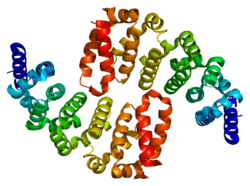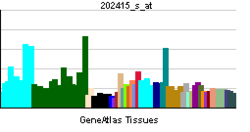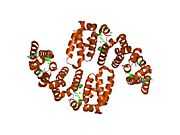HSPBP1
| HSPA (heat shock 70kDa) binding protein, cytoplasmic cochaperone 1 | |||||||||||||
|---|---|---|---|---|---|---|---|---|---|---|---|---|---|
 PDB rendering based on 1xqr. | |||||||||||||
| |||||||||||||
| Identifiers | |||||||||||||
| Symbols | HSPBP1 ; FES1 | ||||||||||||
| External IDs | OMIM: 612939 MGI: 1913495 HomoloGene: 40827 GeneCards: HSPBP1 Gene | ||||||||||||
| |||||||||||||
| RNA expression pattern | |||||||||||||
 | |||||||||||||
| More reference expression data | |||||||||||||
| Orthologs | |||||||||||||
| Species | Human | Mouse | |||||||||||
| Entrez | 23640 | 66245 | |||||||||||
| Ensembl | ENSG00000133265 | ENSMUSG00000063802 | |||||||||||
| UniProt | Q9NZL4 | Q99P31 | |||||||||||
| RefSeq (mRNA) | NM_001130106 | NM_024172 | |||||||||||
| RefSeq (protein) | NP_001123578 | NP_077134 | |||||||||||
| Location (UCSC) | Chr 19: 55.77 – 55.79 Mb | Chr 7: 4.66 – 4.68 Mb | |||||||||||
| PubMed search | |||||||||||||
Hsp70-binding protein 1 is a protein that in humans is encoded by the HSPBP1 gene.[1][2][3]
Interactions
HSPBP1 has been shown to interact with HSPA8[4][5] and HSPA4.[6]
References
- ↑ Raynes DA, Guerriero V (May 2000). "Isolation and characterization of isoforms of HspBP1, inhibitors of Hsp70". Biochim Biophys Acta 1490 (1-2): 203–7. doi:10.1016/s0167-4781(99)00238-9. PMID 10786638.
- ↑ Raynes DA, Guerriero V Jr (Jan 1999). "Inhibition of Hsp70 ATPase activity and protein renaturation by a novel Hsp70-binding protein". J Biol Chem 273 (49): 32883–8. doi:10.1074/jbc.273.49.32883. PMID 9830037.
- ↑ "Entrez Gene: HSPBP1 hsp70-interacting protein".
- ↑ Rual, Jean-François; Venkatesan Kavitha, Hao Tong, Hirozane-Kishikawa Tomoko, Dricot Amélie, Li Ning, Berriz Gabriel F, Gibbons Francis D, Dreze Matija, Ayivi-Guedehoussou Nono, Klitgord Niels, Simon Christophe, Boxem Mike, Milstein Stuart, Rosenberg Jennifer, Goldberg Debra S, Zhang Lan V, Wong Sharyl L, Franklin Giovanni, Li Siming, Albala Joanna S, Lim Janghoo, Fraughton Carlene, Llamosas Estelle, Cevik Sebiha, Bex Camille, Lamesch Philippe, Sikorski Robert S, Vandenhaute Jean, Zoghbi Huda Y, Smolyar Alex, Bosak Stephanie, Sequerra Reynaldo, Doucette-Stamm Lynn, Cusick Michael E, Hill David E, Roth Frederick P, Vidal Marc (Oct 2005). "Towards a proteome-scale map of the human protein-protein interaction network". Nature (England) 437 (7062): 1173–8. doi:10.1038/nature04209. PMID 16189514.
- ↑ Stelzl, Ulrich; Worm Uwe, Lalowski Maciej, Haenig Christian, Brembeck Felix H, Goehler Heike, Stroedicke Martin, Zenkner Martina, Schoenherr Anke, Koeppen Susanne, Timm Jan, Mintzlaff Sascha, Abraham Claudia, Bock Nicole, Kietzmann Silvia, Goedde Astrid, Toksöz Engin, Droege Anja, Krobitsch Sylvia, Korn Bernhard, Birchmeier Walter, Lehrach Hans, Wanker Erich E (Sep 2005). "A human protein-protein interaction network: a resource for annotating the proteome". Cell (United States) 122 (6): 957–68. doi:10.1016/j.cell.2005.08.029. ISSN 0092-8674. PMID 16169070.
- ↑ Oh, Won-Kyung; Song Jaewhan (Aug 2003). "Cooperative interaction of Hsp40 and TPR1 with Hsp70 reverses Hsp70-HspBp1 complex formation". Mol. Cells (Korea (South)) 16 (1): 84–91. ISSN 1016-8478. PMID 14503850.
Further reading
- Zou J, Guo Y, Guettouche T et al. (1998). "Repression of heat shock transcription factor HSF1 activation by HSP90 (HSP90 complex) that forms a stress-sensitive complex with HSF1.". Cell 94 (4): 471–80. doi:10.1016/S0092-8674(00)81588-3. PMID 9727490.
- Kabani M, McLellan C, Raynes DA et al. (2002). "HspBP1, a homologue of the yeast Fes1 and Sls1 proteins, is an Hsc70 nucleotide exchange factor.". FEBS Lett. 531 (2): 339–42. doi:10.1016/S0014-5793(02)03570-6. PMID 12417338.
- Strausberg RL, Feingold EA, Grouse LH et al. (2003). "Generation and initial analysis of more than 15,000 full-length human and mouse cDNA sequences.". Proc. Natl. Acad. Sci. U.S.A. 99 (26): 16899–903. doi:10.1073/pnas.242603899. PMC 139241. PMID 12477932.
- McLellan CA, Raynes DA, Guerriero V (2003). "HspBP1, an Hsp70 cochaperone, has two structural domains and is capable of altering the conformation of the Hsp70 ATPase domain.". J. Biol. Chem. 278 (21): 19017–22. doi:10.1074/jbc.M301109200. PMID 12651857.
- Oh WK, Song J (2004). "Cooperative interaction of Hsp40 and TPR1 with Hsp70 reverses Hsp70-HspBp1 complex formation.". Mol. Cells 16 (1): 84–91. PMID 14503850.
- Ota T, Suzuki Y, Nishikawa T et al. (2004). "Complete sequencing and characterization of 21,243 full-length human cDNAs.". Nat. Genet. 36 (1): 40–5. doi:10.1038/ng1285. PMID 14702039.
- Lu QF, Bai M, Zhang HJ et al. (2004). "[Co-detection of P21, P53 and HSP70 and their possible role in diagnosis of polycyclic aromatic hydrocarbons (PAHs)-related lung cancer]". Zhonghua Lao Dong Wei Sheng Zhi Ye Bing Za Zhi 21 (5): 359–61. PMID 14761400.
- Alberti S, Böhse K, Arndt V et al. (2005). "The cochaperone HspBP1 inhibits the CHIP ubiquitin ligase and stimulates the maturation of the cystic fibrosis transmembrane conductance regulator.". Mol. Biol. Cell 15 (9): 4003–10. doi:10.1091/mbc.E04-04-0293. PMC 515335. PMID 15215316.
- Gerhard DS, Wagner L, Feingold EA et al. (2004). "The status, quality, and expansion of the NIH full-length cDNA project: the Mammalian Gene Collection (MGC).". Genome Res. 14 (10B): 2121–7. doi:10.1101/gr.2596504. PMC 528928. PMID 15489334.
- Shomura Y, Dragovic Z, Chang HC et al. (2005). "Regulation of Hsp70 function by HspBP1: structural analysis reveals an alternate mechanism for Hsp70 nucleotide exchange.". Mol. Cell 17 (3): 367–79. doi:10.1016/j.molcel.2004.12.023. PMID 15694338.
- Stelzl U, Worm U, Lalowski M et al. (2005). "A human protein-protein interaction network: a resource for annotating the proteome.". Cell 122 (6): 957–68. doi:10.1016/j.cell.2005.08.029. PMID 16169070.
- Dai Q, Qian SB, Li HH et al. (2006). "Regulation of the cytoplasmic quality control protein degradation pathway by BAG2.". J. Biol. Chem. 280 (46): 38673–81. doi:10.1074/jbc.M507986200. PMID 16169850.
- Rual JF, Venkatesan K, Hao T et al. (2005). "Towards a proteome-scale map of the human protein-protein interaction network.". Nature 437 (7062): 1173–8. doi:10.1038/nature04209. PMID 16189514.
- Otsuki T, Ota T, Nishikawa T et al. (2007). "Signal sequence and keyword trap in silico for selection of full-length human cDNAs encoding secretion or membrane proteins from oligo-capped cDNA libraries.". DNA Res. 12 (2): 117–26. doi:10.1093/dnares/12.2.117. PMID 16303743.
- Gottwald E, Herschbach M, Lahni B et al. (2006). "Expression of the cochaperone HspBP1 is not coordinately regulated with Hsp70 expression.". Cell Biol. Int. 30 (6): 553–8. doi:10.1016/j.cellbi.2006.03.005. PMID 16677834.
- Lim J, Hao T, Shaw C et al. (2006). "A protein-protein interaction network for human inherited ataxias and disorders of Purkinje cell degeneration.". Cell 125 (4): 801–14. doi:10.1016/j.cell.2006.03.032. PMID 16713569.
- Bivik C, Rosdahl I, Ollinger K (2007). "Hsp70 protects against UVB induced apoptosis by preventing release of cathepsins and cytochrome c in human melanocytes.". Carcinogenesis 28 (3): 537–44. doi:10.1093/carcin/bgl152. PMID 16950797.
- Swayne LA, Braun JE (2007). "Aggregate-centered redistribution of proteins by mutant huntingtin.". Biochem. Biophys. Res. Commun. 354 (1): 39–44. doi:10.1016/j.bbrc.2006.12.129. PMID 17208201.
| |||||||||||

